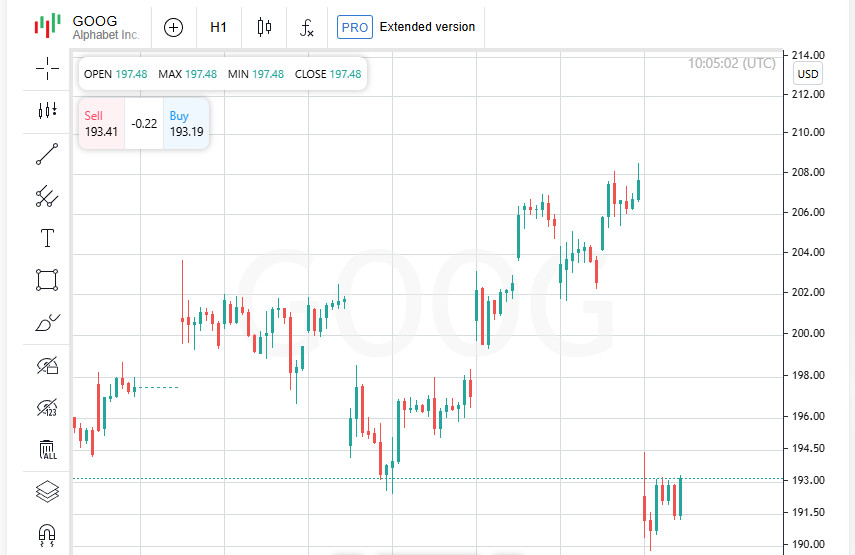Wall Street closed in the green: investors ignore Alphabet's failures and bet on the future
US stock markets ended trading on Wednesday with confident growth, managing to recoup the morning's decline. Investors remained unperturbed by Alphabet's disappointing financial results and focused on the prospects of interest rate cuts by the US Federal Reserve.
Alphabet under pressure: cloud revenue and big AI investments
Alphabet (GOOGL.O), the holding company that owns Google, fell 7.3% after reporting weak revenue growth in the cloud segment. The company was further pressured by plans to spend a record $75 billion on artificial intelligence in 2024, which was higher than analysts expected.
AI-related stocks are on the mend
After a recent wave of selling caused by the excitement around the Chinese low-cost AI model from the startup DeepSeek, the shares of some tech companies went up again. Thus, Nvidia (NVDA.O), which suffered significant losses last week, jumped by 5.4%, and Broadcom (AVGO.O) added 4.3%.
"Demand for artificial intelligence will not disappear, despite the news about DeepSeek. "All players will have to continue to invest in technology, which makes this a long-term story," said Rob Haworth, chief investment strategist at U.S. Bank Asset Management.
AMD sees decline after Lisa Su's statement
Advanced Micro Devices (AMD.O) shares were under pressure, falling 6.3%. This happened after the company's CEO Lisa Su warned that data center revenue would fall 7% in the current quarter. This figure is considered a proxy for AMD's AI revenue.
Focus on macroeconomics: the market awaits the employment report
Investors are eagerly awaiting fresh data on the state of the U.S. labor market. The key non-farm payrolls report for January is due out on Friday and could influence expectations for the Fed's next steps.
Is the U.S. economy slowing: a signal for the Fed or a temporary slowdown?
U.S. service sector business activity unexpectedly fell in January, indicating a decline in consumer demand. This, in turn, helped contain inflationary pressures, according to fresh data from the Institute for Supply Management (ISM) released on Wednesday.
Slowing growth: a warning sign or good news?
The slowdown in business activity has sparked debate among economists and investors. Some fear that the U.S. economy is entering a slowdown, which could force the Federal Reserve to act faster by cutting its key interest rate.
"There are concerns that the Fed will have to ease monetary policy faster than expected as the economy shows signs of weakening. However, for markets, this is more of a positive factor, because rate cuts are exactly what they are looking for," said Rob Haworth, senior investment strategist at U.S. Bank Asset Management.
When to expect the Fed's decision?
The next meeting of the Federal Open Market Committee (FOMC) is scheduled for March. However, according to the FedWatch tool from CME, the probability of a rate cut during this period remains low - only 16.5% of traders are considering this scenario. The main expectations are shifted to June, when most market participants predict the first step towards easing monetary policy.
The Fed takes into account political and economic risks
Federal Reserve Bank of Richmond President Thomas Barkin said that the Fed is leaning towards further rate cuts in 2024. However, he stressed that the regulator will have to take into account many external factors that can affect the economy. Among them, he named changes in trade policy, migration issues, new regulatory measures and initiatives of the US President Donald Trump's administration.
Thus, financial markets continue to monitor economic signals, trying to predict the Fed's next move. The focus remains on how quickly the regulator will decide to cut rates and how much impact this will have on economic growth.
US stocks continue to rise as investors balance risks and prospects
US stock indices ended Wednesday in positive territory, continuing their upward trend despite mixed news on the corporate and geopolitical front. Investors showed cautious optimism in response to quarterly corporate reports and expectations about future Fed policy.
Dow, S&P 500, Nasdaq Gain
The Dow Jones Industrial Average (.DJI) added 317.24 points, or 0.71%, to close at 44,873.28. The S&P 500 (.SPX) rose 0.39% to 6,061.48. The tech-heavy Nasdaq Composite (.IXIC) rose 0.19% to 19,692.33.
Real Estate Advances, Communications Slips
Eight of the 11 S&P 500 sectors ended the day higher, led by Real Estate (.SPLRCR). However, Communications Services (.SPLRCL) fell nearly 3%, reflecting pressure on key industry players.
Apple Under Pressure Over China Antitrust Investigation
Apple (AAPL.O) shares fell slightly by 0.1% after Bloomberg News reported that Chinese regulators may be investigating the company for an antitrust probe. That could heighten tensions between the company and its largest Asian market, where Apple already faces challenges from growing competition and the rise of local brands.
Uber Disappoints Investors: Shares Plunge 7.6%
Uber Technologies (UBER.N) shares came under pressure, falling 7.6%. The company's disappointing guidance for the current quarter, with orders falling short of analysts' expectations, raising concerns about how fast the business can grow in a competitive environment.
Fiserv Surprises Markets: Shares Soar 7.1%
Fiserv (FI.N), on the other hand, pleased investors. The financial technology company posted strong fourth-quarter results, beating analysts' estimates. The gains were driven by rising demand for its banking and payment services, with the company's shares soaring 7.1%.
Geopolitics Remains in Focus: Trump Hints at Trade War Escalation
Investors continue to monitor trade relations between the United States and China. On Tuesday, Donald Trump said he was in no rush to negotiate with Chinese President Xi Jinping, raising concerns about a possible escalation of the trade conflict. The announcement has caused anxiety in markets, as further escalation of tariffs could put pressure on the global economy.
Wall Street Remains Calm: Volatility Index Falls
Despite all the turmoil, the Cboe Volatility Index (.VIX), known as Wall Street's "fear gauge," fell 7.9% to 15.85. This signals that investors generally remain confident in the stability of the market despite the risks.
Markets on the move: 'Fear Gauge' jumps, companies face challenges
Markets remain tense as Wall Street's "fear gauge" swings wildly. Several factors are driving the price action: trade tariffs, inflation risks, and the huge costs of artificial intelligence. Investors are trying to gauge which of these challenges will have the biggest impact in the near term.
FMC plunges 33.5% as agrochemical giant disappoints on outlook
Shares in FMC Corp (FMC.N) plunged 33.5% after the agrochemical maker gave a grim first-quarter revenue outlook. The company warned it would miss its expectations, prompting a sharp negative reaction from the market. It was FMC's biggest drop in a decade, reflecting investor concerns about demand in the agricultural sector.
Johnson Controls Up 11.3% With New CEO, Ambitious Plans
At the other end of the spectrum, Johnson Controls (JCI.N) posted solid gains, adding 11.3%. The catalyst was a surprise management move: the company announced the appointment of Joakim Vaidemanis as CEO. At the same time, Johnson Controls raised its 2025 profit forecast, spurring investor interest and strengthening the company's position in the construction and engineering sectors.
Ford Faces New Challenges as Electric Vehicle Losses Continue
Automaker Ford Motor (F.N) expects its electric vehicle and software division to post losses of $5.5 billion in 2024, flat with last year, signaling serious challenges to the company's strategy to reduce the costs of producing electric models.
The company said it expects to be profitable by 2025, but even that forecast was weaker than market expectations. Still, Ford managed to post a net profit of $1.8 billion in the fourth quarter, a significant improvement from a $500 million loss a year earlier when results were weighed down by high pension costs.
Ford Under Threat: Trump's Potential Tariffs Complicate Matters
In addition to its domestic challenges, Ford faces potential geopolitical risks. Donald Trump has threatened to impose new tariffs on imports from Mexico and Canada, which could significantly increase the automaker's costs for purchasing raw materials. These measures, if implemented, could not only worsen Ford's financial performance, but also reduce demand for cars due to higher prices.
The company's shares have already lost 18% of their value over the past 12 months, and investors are watching with concern how things will develop further.
Ford Bets on Hybrids as GM Pushes Electric Vehicles Aggressively
Ford is set to change its strategy in the electric vehicle segment, temporarily suspending the release of new models next year. Unlike General Motors (GM.N), which is actively expanding its lineup of electric vehicles, including the Blazer EV and Equinox EV, Ford is betting on hybrid technology, which, according to experts, could become a key advantage for the company in the coming years.
Betting on Hybrids: Ford's Pragmatic Move
Ford CEO Jim Farley believes that a multi-pronged approach to powertrains will help the company mitigate the negative impact on sales, especially if the Trump administration ends the tax credit for electric vehicles.
"Ford wins because it has flexibility. Unlike GM, which is focusing exclusively on battery electric vehicles and won't introduce hybrid models until 2027, Ford is already offering alternatives," explains CFRA Research analyst Garrett Nelson.
The Trump administration is considering eliminating the $7,500 federal tax credit currently available for some electric vehicles. If that happens, Ford, which relies on hybrids, will be in a better position than GM, which is focused on all-electric vehicles.
Ford Under Pressure: New U.S. Tariffs on Mexican and Canadian Goods
Ford was the first major automaker to report earnings after Trump signed an executive order imposing 25% tariffs on imports from Mexico and Canada. The move, if implemented, would hurt the U.S. auto industry, including Ford, GM, and Stellantis (STLAM.MI).
However, after talks with Canadian and Mexican leaders, the president delayed the tariffs for a month, giving automakers time to adjust and potentially negotiate a way to reduce the impact on the industry.
How Could Tariffs Affect Ford?
If the tariffs go into effect, they would impact production of key Ford models, including:
- The Ford Maverick, a popular and affordable pickup truck built in Mexico;
- The Ford Bronco Sport, a compact SUV built overseas;
- The Mustang Mach-E, an electric crossover also built in Mexico.
Despite the potential challenges, analysts say that among Detroit's three largest automakers (Ford, GM, and Stellantis), Ford is the one least vulnerable to new trade restrictions. GM and Stellantis have significantly more profitable models manufactured outside the U.S., making them more susceptible to trade war risks.
Hybrids, Tariffs, and an Uncertain Future
Ford is in a difficult, but not hopeless situation. On the one hand, its focus on hybrids can help the company weather potential tax policy changes and remain competitive. On the other hand, tariffs create new challenges for supply chains that could make cars more expensive and reduce demand.
Now investors are waiting for the White House to take further steps and for automakers to respond to the coming changes in the industry.












